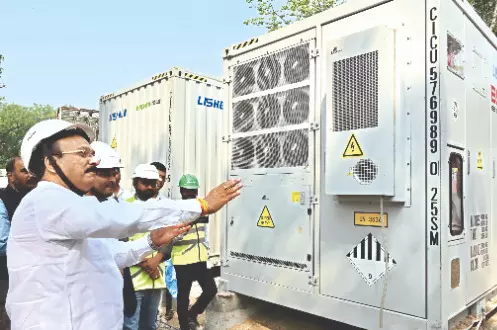Min Sood reviews progress of South Asia’s largest standalone BESS facility

New Delhi: In a landmark step towards modernising Delhi’s power infrastructure and enhancing grid reliability, Delhi Power minister Ashish Sood on Wednesday reviewed the progress of South Asia’s largest standalone Battery Energy Storage System (BESS) in Kilokri, South Delhi. The utility-scale 20 MW/40 MWh system, installed at the 33/11 kV BSES Rajdhani Power Limited substation, is India’s first commercially approved BESS designed to support grid stabilisation, renewable energy integration, and peak demand management.
Calling it a game-changer, Ashish Sood said, “This is not just a power project, it is a grid transformation project. The Battery Energy Storage System will allow us to stabilise electricity supply, reduce peak load stress, and store surplus renewable energy for later use.” He added that strengthening grid reliability and adopting clean energy are key goals of the Delhi government under CM Rekha Gupta.
Installed at BRPL’s 33/11 kV substation in Kilokri, the BESS can supply four hours of power daily, two during the day and two at night, benefiting nearly one lakh residents in the Kilokri and Ashram areas.
The Kilokri BESS project has been implemented through a collaborative partnership involving BSES Rajdhani Power Limited (BRPL), IndiGrid—India’s first listed infrastructure investment trust in the power sector, Global Energy Alliance for People and Planet (GEAPP), a global non-profit supporting equitable and sustainable energy transitions, amperehour and TERI.
Sood said, “This project enables real-time grid balancing and acts as a cushion against outages and surges. It will help Delhi’s discoms transition into Distribution System Operators, which is key to modernising our power systems.” He emphasised that the BESS will also support the integration of renewable energy sources and improve Delhi’s compliance with national grid codes. The system uses Lithium Iron Phosphate (LFP) battery technology, known for safety, thermal stability, and long service life. The battery units are housed in temperature-controlled containers, making them suitable for Delhi’s urban climate conditions. The project was executed in a record 10–12 months, setting a benchmark for rapid deployment of large-scale energy storage systems.
“This project also marks a regulatory breakthrough,” said the Minister. “It is the first commercial standalone BESS in India to get approval for a capacity tariff from
the Delhi Electricity Regulatory Commission. It creates a template for other state electricity commissions and discoms across India.”
The project offers significant economic benefits, including peak shaving, power purchase cost optimisation, and deferred infrastructure upgrades. It is also eligible to participate in the Secondary Reserve Ancillary Services (SRAS), making it a strategic asset for national grid management. “With an annual tariff of Rs 57.6 lakh per MW, 55 percent lower than earlier benchmarks, this project is not just innovative but also economically viable,” said Sood. Responding to misinformation about power supply and subsidies, he said, “Opposition leaders are trying to spread confusion with lies and online bot campaigns. But the truth is clear, our government is investing in the future while continuing to provide relief through the electricity subsidy scheme.”



